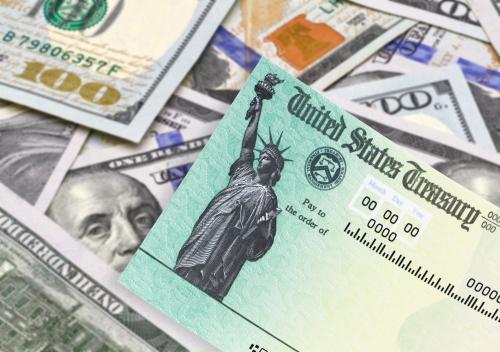A few facts about the federal debt:
One, the federal debt is larger than it has been at any time since the end of World War II.
Two, because the tax code won’t yield enough revenue to cover projected future spending, the federal debt will continue rising and is on an unsustainable trajectory—unless Congress does something.
Three, interest rates, the ones that the market sets, have been declining for decades, are now at historic lows, and—best guess—are likely to remain low for the foreseeable future.
With those facts in mind, what should Joe Biden and Congress be doing, budget-wise, next year?
Should they borrow more to pay for coronavirus-related relief to the unemployed, to those who can’t afford food, to prevent state and local governments from cutting back, to bolster the public health system?
Yes, both to alleviate suffering and to get the economy back to full employment.
Should they worry NOW about the rising federal debt?
No. The federal government is borrowing huge sums of money and paying interest at less than 1 percent on 10-year debt and about 1.6 percent on 30-year debt. At those low rates—lower than the rate of inflation—the U.S. government can sustainably service a much larger federal debt than most of us used to think possible.
Looking beyond the COVID-19 pandemic, when should Congress pay for spending increases either with tax increases or offsetting spending cuts, and when it is okay to borrow?
We should not throw ourselves a party just because we can borrow so cheaply. A simple rule would be that we should pay for things today that we consume today—that means defense, Social Security, medical care for older people, park rangers, airport security, salaries of most bureaucrats. But we should not hesitate to borrow at today’s very low interest rates for public investments that will pay off in the future—including basic science, spreading broadband across the country, roads where they are really needed, health care and education for children in poor families.
You might ask: How do we decide what’s investment—and thus okay to borrow for—and what’s not?
It’s hard, and there’s a temptation to say that spending one favors is “investment” no matter what it is. But that shouldn’t stop us from increasing federal spending on things for which there is a strong evidence of a payoff in the future—like Pre-K, or getting rid of lead pipes in water systems, or developing technologies to arrest global warming.
If we can pay for infrastructure spending with, say, a higher gas tax, or with higher taxes on the very well-off—great, let’s do that. But if we can’t get that through Congress, better to borrow to make those investments than not to make them at all.
Doesn’t government borrowing crowd out private borrowing and investment?
At some point, yes, but the fact that interest rates are so persistently low tells us that right now that is not the problem. Low interest rates are a signal that there’s a lot of savings in the world economy relative to the private demand to use it to fund investment. While federal borrowing does tend to push up interest rates, right now and for the foreseeable future other more powerful factors are pushing them down—and I am not talking about the Federal Reserve; I’m talking about things like demographics, productivity, and technology.
Shouldn’t we worry about bequeathing a lot of debt to the next generation?
We should worry about our kids and our grandkids. But what will be best for them 25 or 50 years from now? A smaller federal debt and less public investment OR a larger debt and more productivity-enhancing public investment and, thus, a higher standard of living? At today’s very low interest rates, there’s a good argument for the latter.
What if interest rates surprise the experts and the markets, and go up a lot?
That is, indeed, a risk. Interest rates are likely to rise somewhat from today’s ultra-low levels. (The Congressional Budget Office expects the rate on 10-year Treasury notes, now around 0.9 percent, to average 1.3 percent over the next five years and 2.8 percent over the five years after that. The financial markets expect some increase, but not that much.) A sharper-than-anticipated increase in interest rates could prompt Congress to raise taxes and cut spending, although it’s harder to cut spending on benefits quickly. But the choice we face is between (a) taking our insurance and doing a lot now to avoid the possibility that we need to scramble later, or (b) doing too little spending now and starving society of sorely-needed public investment.
But if something is unsustainable—and I did say the federal debt can’t keep rising as a share of the economy indefinitely—won’t we have to do something someday?
Almost surely. Federal revenues, measured as a share of the economy, are at historic lows. And those revenues are not even sufficient to cover current federal spending, let alone the higher spending projected in the future. Federal spending is rising primarily for two reasons: (1) We are an aging society, in large part because women are having fewer kids, and the federal government spends a lot on the elderly. And (2) health care spending rises faster than other things (though actually not quite so much faster as it used to), and the government pays a big part of the national health bill. So, unless the economy evolves in ways that are far different from what we expect, we will eventually have to raise taxes or cut benefits, or both. And, in any case, we need to continue to work to make the world’s most expensive health care system more efficient so it can deliver good care at lower cost.
Low interest rates don’t eliminate the need for those politically tough choices, but they do buy us some time.





Commentary
Op-edHow much should we worry today about the rising federal debt?
December 14, 2020